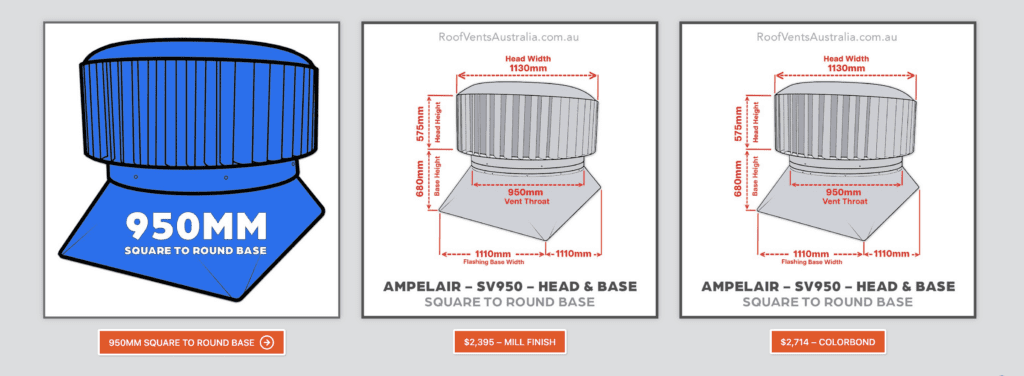Maximizing Roof Efficiency: The Best Roof Vents and Materials for Australian Climate

Rain Heads Custom Made Shipped Free Australia Wide – Click Here >
Dambuster Rain Heads Shipped Free Australia Wide – Click Here >
Commercial Industrial Roof Vents 300mm-950mm – Click Here >
Eco-Friendly Roofing Insulation Shipped Free – Click Here >
Gutter Sumps Shipped Free Australia Wide – Click Here >
Introduction
Australia’s diverse climate poses unique challenges for building owners and contractors. The region’s geography encompasses everything from arid deserts to humid tropics, which means the roofing needs for buildings can differ significantly from one state to another. This article aims to guide you through the essentials of roof ventilation and material choices, focusing on commercial rotary roof vents, metal roof replacement in Brisbane, toilet vents for commercial buildings, and stainless steel roof vents in Melbourne.
The Importance of Adequate Roof Ventilation
Roof ventilation is crucial for maintaining an energy-efficient building. Properly installed roof vents can provide numerous benefits, including reduced energy bills, increased lifespan of roofing materials, and a healthier living environment (Queensland Building and Construction Commission, 2018). According to the Australian Building Codes Board, inadequate ventilation can lead to moisture build-up, which might result in the corrosion of metal parts, rotting of wood, and growth of mould and bacteria.
Best Roof Vents for Australian Climate
The type of roof vent that is ideal for your building will depend on your location, as well as the specific needs of your establishment. Here are some suggestions based on climatic conditions:
- Whirlybirds or Rotary Vents: These are most effective in hot, dry climates like that of Perth. The commercial rotary roof vents are particularly useful for large structures like warehouses (Climate Control News, 2019).
- Ridge Vents: Suited for areas with moderate temperatures, these vents run along the peak of the roof and provide uniform cooling (Housing Industry Association, 2017).
- Gable Vents: These are best for areas with high winds, like coastal regions in South Australia.
- Static Vents: Recommended for humid climates as in Brisbane, these allow moisture to escape more effectively (Australian Government’s YourHome website).
Roof Ventilation Products in Perth
Given Perth’s hot and dry climate, commercial rotary roof vents are highly recommended. These rotary vents are generally constructed with durable materials like aluminium or stainless steel, providing longevity and efficiency. Companies like Edmonds Ventilation and CSR Bradford offer a range of rotary vents that are designed to withstand harsh climates, including the Australian summer heat (Australian Business Review, 2020).
The Role of Material in Roof Replacement
When considering roof replacement, the material you choose is as crucial as the type of vent you install.
Metal Roof Replacement in Brisbane
In humid subtropical climates like Brisbane, metal roofing materials such as Colorbond or Zincalume are highly recommended (Master Builders Queensland, 2020). These materials are corrosion-resistant, durable, and provide excellent thermal efficiency. Businesses like Metal Roofing Online and Just Roofing Supplies have a wide range of options tailored for the Brisbane climate.
Ventilation for Commercial Buildings: Beyond the Roof
While roof ventilation is vital, other types of vents like toilet vents are also important in a commercial setting.
Toilet Vents for Commercial Buildings
Inadequate toilet ventilation can lead to poor air quality, affecting the health of the occupants and leading to unpleasant odours. Commercial-grade exhaust fans, ducted systems, and even heat-exchange ventilation systems can help maintain a healthy indoor environment (Fair Trading NSW, 2019).
Special Focus: Stainless Steel Roof Vents in Melbourne
In Melbourne’s temperate oceanic climate, stainless steel roof vents provide an excellent blend of durability and aesthetic appeal. Stainless steel is resistant to rust and corrosion, making it an ideal material for regions with variable weather conditions (Engineers Australia, 2015). Companies like Skydome Skylight Systems and Vent-A-Roof offer various stainless steel roof vent options designed for Melbourne’s specific climatic needs.
Conclusion
Selecting the right roofing material and ventilation system is critical for any building’s longevity and efficiency. For hot, arid climates like Perth, commercial rotary roof vents are ideal, whereas in humid regions like Brisbane, metal roofs with static vents may be more appropriate. Specialized vents like toilet vents for commercial buildings and stainless steel roof vents for Melbourne’s temperate climate offer further tailored solutions. By understanding your local climate and consulting experts in the field, you can make informed decisions that lead to long-term benefits for your building and its occupants.
References
- Queensland Building and Construction Commission. (2018). The importance of roof ventilation. Retrieved from https://www.qbcc.qld.gov.au/blog/maintenance-repairs/importance-roof-ventilation
- Climate Control News. (2019). Rotary Vents: Cooling Large Commercial Spaces. Retrieved from https://www.climatecontrolnews.com.au/news/latest/rotary-vents-cooling-large-commercial-spaces
- Housing Industry Association. (2017). Roof Ventilation Solutions. Retrieved from https://hia.com.au/
- Australian Building Codes Board. National Construction Code. Retrieved from https://ncc.abcb.gov.au/
- Australian Government’s YourHome website. Ventilation. Retrieved from https://www.yourhome.gov.au/passive-design/ventilation
- Australian Business Review. (2020). Best Roofing Options for Australian Climate. Retrieved from https://www.aus-business-review.com.au/best-roofing-options-for-australian-climate
- Master Builders Queensland. (2020). Choosing the Right Roof Material. Retrieved from https://www.mbqld.com.au/news-and-publications/publications/trade-ready/choosing-the-right-roof-material
- Fair Trading NSW. (2019). Building Guidelines for Ventilation. Retrieved from https://www.fairtrading.nsw.gov.au/
- Engineers Australia. (2015). Material Choices in Australian Climate. Retrieved from https://www.engineersaustralia.org.au/
With proper planning and installation, you can achieve an energy-efficient, healthy, and cost-effective roofing solution for any building, regardless of your Australian locale. Now is the time to act—evaluate your roofing and ventilation options today to ensure a better tomorrow.

